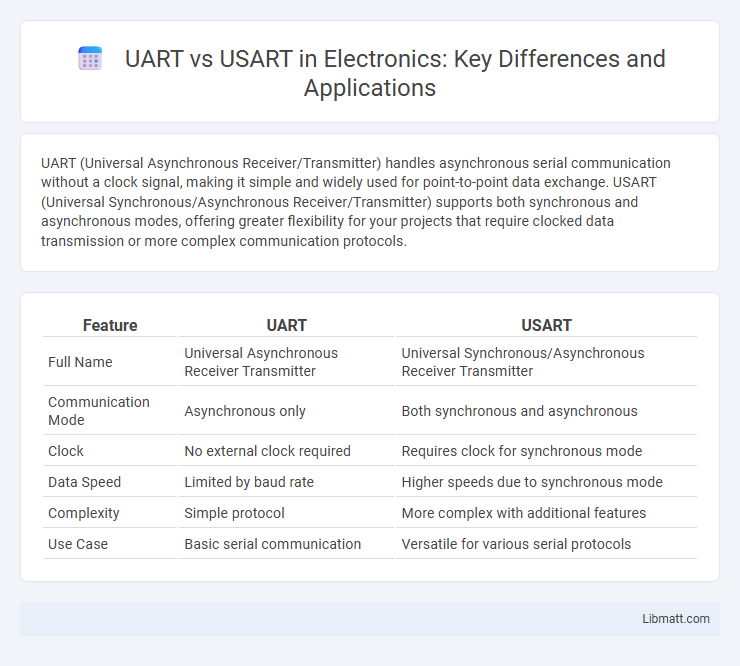UART (Universal Asynchronous Receiver/Transmitter) handles asynchronous serial communication without a clock signal, making it simple and widely used for point-to-point data exchange. USART (Universal Synchronous/Asynchronous Receiver/Transmitter) supports both synchronous and asynchronous modes, offering greater flexibility for your projects that require clocked data transmission or more complex communication protocols.
Table of Comparison
| Feature | UART | USART |
|---|---|---|
| Full Name | Universal Asynchronous Receiver Transmitter | Universal Synchronous/Asynchronous Receiver Transmitter |
| Communication Mode | Asynchronous only | Both synchronous and asynchronous |
| Clock | No external clock required | Requires clock for synchronous mode |
| Data Speed | Limited by baud rate | Higher speeds due to synchronous mode |
| Complexity | Simple protocol | More complex with additional features |
| Use Case | Basic serial communication | Versatile for various serial protocols |
Overview of UART and USART
UART (Universal Asynchronous Receiver/Transmitter) is a hardware communication protocol that enables asynchronous serial communication between devices by converting parallel data into serial form and vice versa. USART (Universal Synchronous/Asynchronous Receiver/Transmitter) extends UART functionality by supporting both asynchronous and synchronous communication modes, allowing precise clock synchronization for higher data transfer rates. Both UART and USART are integral to embedded systems, microcontrollers, and serial communication interfaces, with USART offering increased flexibility in communication protocols.
Key Differences Between UART and USART
UART (Universal Asynchronous Receiver Transmitter) operates solely with asynchronous serial communication, while USART (Universal Synchronous/Asynchronous Receiver Transmitter) supports both synchronous and asynchronous modes. UART transmits data without a clock signal, relying on start and stop bits for framing, whereas USART can synchronize data transfer using a clock signal in synchronous mode, enhancing speed and reliability. The configurable baud rate in USART allows greater flexibility compared to UART's fixed asynchronous transmission parameters.
How UART Works
UART works by converting parallel data from a microcontroller into serial form for transmission and then converting received serial data back into parallel form for processing. It employs start bits, data bits, optional parity bits, and stop bits to frame each data packet, ensuring synchronization between the sender and receiver. UART operates asynchronously, relying on precise timing from the baud rate to correctly interpret the data stream without a shared clock signal.
How USART Works
USART (Universal Synchronous/Asynchronous Receiver Transmitter) operates by transmitting data serially, supporting both synchronous and asynchronous communication modes. It uses a clock signal for synchronization in synchronous mode, ensuring precise timing between the transmitter and receiver, while asynchronous mode relies on start and stop bits to frame data. Your device benefits from USART's flexibility, allowing seamless integration with various communication protocols and ensuring reliable serial data transfer.
Data Transmission Modes
UART (Universal Asynchronous Receiver/Transmitter) handles serial data transmission using asynchronous mode where data is sent without a clock signal, relying on start and stop bits for synchronization. USART (Universal Synchronous/Asynchronous Receiver/Transmitter) supports both asynchronous and synchronous modes, enabling data to be transmitted with an external clock signal for precise timing control. Synchronous mode in USART provides higher speed and more reliable data transfer compared to the asynchronous mode of UART.
Hardware Components and Integration
UART interfaces rely on basic hardware components such as a transmit and receive shift register, baud rate generator, and control logic for asynchronous serial communication. USART hardware extends UART functionality by integrating synchronous capability, including clock generators and multiplexers to handle both asynchronous and synchronous data transfer modes. Integration of USART often requires additional pins for clock signals, making it suitable for more complex communication protocols compared to the simpler UART module.
Common Applications of UART
UART is widely used in serial communication for microcontrollers, GPS modules, Bluetooth devices, and simple sensor interfaces, enabling efficient data exchange in embedded systems. It facilitates point-to-point communication in industrial automation, automotive diagnostics, and consumer electronics where asynchronous data transmission is sufficient. Its simplicity and low hardware requirements make UART ideal for interfacing peripheral devices and debugging purposes.
Common Applications of USART
USART (Universal Synchronous/Asynchronous Receiver/Transmitter) is widely used in embedded systems for serial communication in devices such as microcontrollers, modems, and GPS modules due to its versatility in supporting both synchronous and asynchronous modes. Its ability to interface with a variety of peripherals makes it essential in applications requiring reliable data transfer, including industrial automation, automotive diagnostics, and telemetry systems. USART's synchronization capability enables efficient communication in systems demanding precise timing and high data integrity.
Advantages and Limitations
UART offers simplicity and ease of use with asynchronous serial communication, making it ideal for low-cost, short-distance data transfer, but it lacks clock synchronization, which can lead to timing errors. USART supports both asynchronous and synchronous modes, providing greater flexibility and higher data transfer rates due to clock synchronization, but it requires more complex hardware and configuration. Your choice depends on the need for speed and flexibility versus simplicity and cost-effectiveness.
Choosing Between UART and USART
Selecting between UART and USART hinges on communication protocol requirements and hardware capabilities. UART supports asynchronous serial communication with simpler clock management, making it ideal for low-speed, less complex applications. USART offers both asynchronous and synchronous modes, providing versatility and higher data rates, which benefits systems requiring precise timing or multi-device synchronization.
UART vs USART Infographic

 libmatt.com
libmatt.com